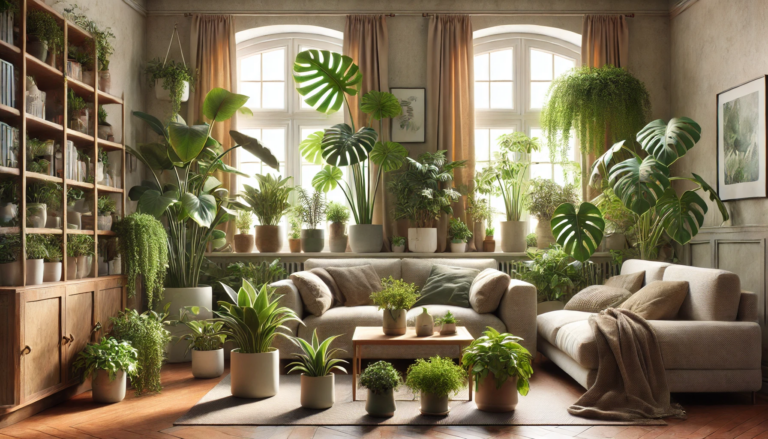For the home, houseplants are more than simply a fashion; they are an opportunity to bring nature into our living spaces and improve the look and wellness of a house. People can change their residence by using housing plants, whether they have been actively gardening for many years or just become parents to some potted flowers. This guide will go through various types of house plants, how they benefit us, and essential care tips for developing a lush indoor garden.
Advantages of House Plants
Cleaner Air
Snake Plant, Spider Plant and Peace Lily are all recognized for their ability to purify air quality. They take in such toxins as formaldehyde and benzene, releasing clean oxygen into the household.
Improved Aesthetics
House plants come in different shapes, sizes, and colours, making them suitable for any interior design style. They range from succulents, which give a minimalistic impression, to giant ferns that create dramatic effects, making every room feel natural.
Better Mental Health
Being around plants can help reduce anxiety, increase attention spans and ameliorate overall mood experiences. Caring for these organisms is rehabilitative, giving individuals who do it relaxation moments while achieving something.
Best House Plants For Your Home
The right choice of houseplants will depend on light availability, space availability, and personal preferences related to maintenance requirements. Here are some popular options:
1. Monstera Deliciosa
With its vast leaves and several splits, Monstera Deliciosa does very well under bright, indirect lighting conditions. It is a demanding plant that adds a tropical taste to any room.
2.ZZ plant (Zamioculcas zamiifolia)
ZZ plant is practically indestructible and, therefore, perfect for beginners. It is tolerant of low light and requires infrequent watering.
3. Aloe Vera
Aloe vera is not only an ornamental plant but also has medicinal uses. It thrives in bright, indirect light with sparing watering.
4. Rubber Plant (Ficus elastica)
Being a great addition to any home due to its shiny dark green leaves, the rubber plant thrives under bright indirect lighting conditions and needs regular watering.
5.Boston Fern (Nephrolepis exaltata)
The Boston Fern boasts feathery, lush fronds. It can be placed in bathrooms or kitchens as it loves high humidity and does well under indirect light conditions.
Taking Care of House Plants
Ensure your house plants remain healthy. It is vital to give them proper care. Here are some essential tips:
Lighting
The light requirement varies among different plants, with some demanding bright but no direct sunlight while others can do well even with very little sunlight. Place them accordingly so that they get appropriate light intensity levels.
Watering
Many people over-water their houseplants, one of the most common mistakes. For most indoor plants, the soil should be left dry between waterings. Before watering, feel the top inch of the soil or use a moisture meter.
Humidity
Many indoor plants, particularly those classified under tropical varieties, like higher humidity environments. Placing water trays next to your houseplants or using humidifiers increases the moisture content in the air surrounding them.
Fertilizing
Make sure you feed your plants with equal parts of water-soluble fertilizer during periods when they are growing, such as spring or summer months; refrain from doing so much composting now that the cold season is on us, i.e., fall and winter periods, which indicate dormancy among these organisms.
Pruning
Consistently trimming assists in keeping their shape and health intact. Removing dead leaves along with yellow ones and cutting back trees that have become too bushy encourages fresh growth in them.
Troubleshooting Common Problems
Even when house plants are best-taken care of, they may still encounter problems. Let’s look at some common issues and their solutions:
Leaves Turning Yellow
Yellow leaves indicate that you have either underwatered or the plant lacks some nutrients. Change your watering pattern if the plant is root-bound, and probably consider repotting it.
Brown Leaf Tips
Low humidity or excessive salts from fertilizers often cause brown tips. For saline soil excess, increase moisture and flood it with water.
Pests
Frequent pests include mites such as spider mites, aphids and mealybugs. Treat bugs using insecticidal soap or neem oil, and isolate affected plants to prevent infestation spread-out.
Summary
Houseplants bring beauty into homes besides being beneficial to people’s health. You can achieve a green sanctuary all year round by selecting suitable plants and caring for them accordingly. Whether you are an experienced planter or just a beginner, there is always a plant that suits you well.
- Growing Bonsai: Tips for Miniature Tree Enthusiasts
- Buying Bonsai: Tips for Selecting Your Perfect Tree
- Bonsai Potting: Essential Tips for Tree Care Success
- Bonsai Maintenance: Essential Care for Tiny Trees
- Mastering the Art of Shaping Bonsai: A Beginner’s Guide
Source: University of Florida Gardening Solutions


